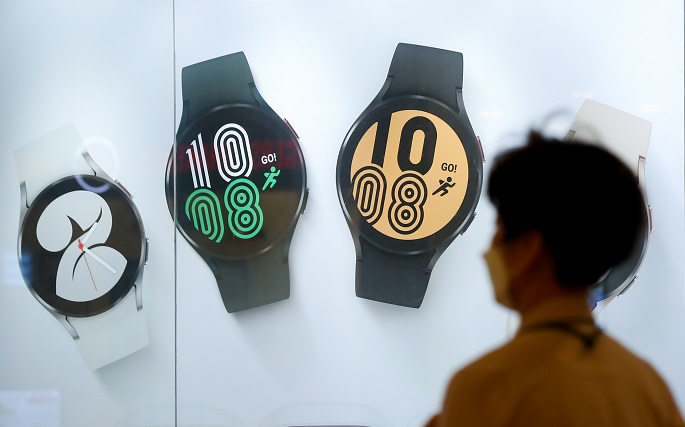
This photo taken on Sept. 15, 2021, shows an outdoor advertisement for Samsung Electronics Co.’s Galaxy Watch4 smartwatch in Seoul. (Yonhap)
SEOUL, Sept. 15 (Korea Bizwire) — Samsung Electronics Co. said Wednesday a study showed Galaxy Watch’s blood pressure monitoring could help Parkinson’s disease (PD) patients as the company emphasizes health and fitness features of its smartwatches.
Citing a study conducted by researchers at Samsung Medical Center in Seoul, the tech giant said blood pressure monitoring on the Galaxy Watch may help PD patients effectively manage orthostatic hypotension, a form of low blood pressure caused by blood vessels failing to constrict.
“Orthostatic hypotension is common among PD patients and can increase the risk of falls for those in the elderly age group and may already have existing cardiovascular diseases,” Samsung said.
“Measuring blood pressure frequently can help detect critical fluctuations for diagnosing and managing PD.”
Blood pressure monitoring is currently available on Samsung’s Galaxy Watch3, Galaxy Watch Active2 and the latest Galaxy Watch4, through pulse wave analysis that is tracked with heart rate monitoring sensors.
Blood pressure monitoring is offered through the Samsung Health Monitor app and is currently offered in 40 countries, including Australia, Brazil and South Korea.
The study, which was published in the latest issue of medical journal Frontiers in Neurology, compared blood pressure measurement data by the Galaxy Watch3 with those measured by a sphygmomanometer to compare accuracy.
The test, titled “Validation of blood pressure measurement using a smartwatch in patients with Parkinson’s disease,” was conducted on 56 patients with a sphygmomanometer reference on one arm and the Galaxy Watch3 on the other.
Each patient had their blood pressure measured with both devices three times.
“Orthostatic hypotension is a common and challenging symptom that affects people living with PD. But it is hard to screen just by observing symptoms, and the problem may go undetected when measuring BP,” the research team said.
“If we could use a smartwatch to measure patients’ BP regularly and detect potential issues at an early stage, it would really help treat and manage PD.”
(Yonhap)






